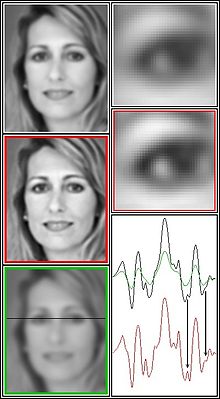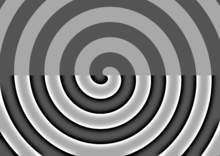Unsharp masking
Unsharp masking ( also: "Selective Sharpness" ) describes a filter method in image processing in which the impression of sharpness of a photo is increased with the help of a blurred copy of this photo.
principle
Sharpened images appear more detailed, as human perception is optimized for recognizing edges and lines (see also Mach strips ). The information content is, like, not increased subsequently carried out in all image operations.
See main article: Sharpening
The principle of unsharp masking is illustrated in the figure: In order to increase the sharpness of the photo in the upper left corner, an unsharp copy is first created, in the lower left corner . In analog technology, a transparent copy was used to expose photos together with the negative of the original. In digital technology, the blurred image is subtracted from the original image and the result is the middle photo. In the enlarged section of the eye on the right, the contrast enhancement can be clearly seen in the brightness transitions caused by the filtering. The diagram at the bottom right shows the brightness distribution of a horizontal line at the height of the eyes. If you subtract the green curve of the blurred image from the black line of the original image, after adjusting the overall contrast, the result is the red line. The arrows point to some areas that show greater fluctuation after the image operation and are interpreted by the eye as an increase in sharpness.
In addition to the degree of blurring of the difference image and the brightness of the difference image, digital technology allows further parameters to be introduced to control the sharpening.

